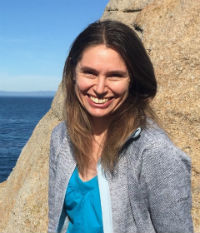Marine reserves, or no-fishing zones, are increasing throughout the world. Their goals are variable and numerous, often a mix of conserving our ocean’s biodiversity and supporting the ability to fish for seafood outside reserves for generations to come. California is one location that has seen the recent implementation of marine reserves, where the California Marine Life Protection Act led to the establishment of one of the world’s largest networks of marine reserves.
A number of scientific efforts have informed the design of marine reserves throughout the world and in California. Mathematical models were central to these research efforts as they let scientists and managers do simulated “experiments” of how different reserve locations, sizes, and distances from each other affect how well reserves might achieve their goals.
While a PhD student in the early 2000s, I began my scientific career as one of many contributing to these efforts. In the process, a key lesson I learned was the value of pursuing partnerships with government agencies such as NOAA Fisheries to ensure that the science I was doing was relevant to managers’ questions, an approach that has become central to my research ever since.

Map of the California Marine Protected Areas; courtesy of California Department of Fish and Wildlife
A transition from design to testing
Now, with many marine reserves in place, both managers and scientists are turning to the question of whether they are working. On average (but not always), marine reserves harbor larger fish and larger population sizes for fished species, as well as greater total biomass and diversity, compared both to before reserves were in place and to areas outside reserves. However, answering a more nuanced question—for a given reserve system, is it working as expected?—can help managers engage in “adaptive management”: using the comparison of expectations to data to identify any shortfalls and adjust management or scientific understanding where needed to better achieve the original goals.
Mathematical models are crucial to calculating expectations and therefore to answering this question. The original models used to answer marine reserve design questions focused on responses that might occur after multiple decades. Now models must focus on predicting what types of changes might be detectable over the 5-15 year time frame of reserve evaluation. Helping to develop such modeling tools as part of a larger collaboration, with colleagues Alan Hastings and Louis Botsford at UC Davis and Will White at the University of North Carolina, is the focus of my latest research on marine reserves in an ongoing project that started shortly after I arrived as a professor at UC Davis.
To date we have developed new models to investigate how short-term expectations in marine reserves depend on fish characteristics and fishing history. Now we have a new partnership with California’s Department of Fish and Wildlife, the responsible management agency for California’s marine reserves, to collaboratively apply these tools to our statewide reserve system. This application will help rigorously test how effective California’s marine reserves are, and therefore help with continually improving management to support both the nutrition and recreation that Californians derive from the sea. In addition, it will let California serve as a leading example of model-based adaptive management that could be applied to marine reserves throughout the world.
The role of federal funding

The cabezon is just one type of fish protected from fishing in California’s marine reserves. Photo credit: Wikimedia Commons.
Our project on models applied to adaptive managed started with funding in 2010–2014 from NOAA SeaGrant, a funding source uniquely suited to support research that can help improve ocean and fisheries management. With this support, we could be forward-looking about developing the modeling tools that the State of California now needs. NOAA SeaGrant would be eliminated under the current administration’s budget proposal.
My other experience with NOAA SeaGrant is through a graduate student fellowship program that has funded PhD students in my (and my colleagues’) lab group to do a variety of marine reserve and fisheries research projects. This fellowship funds joint mentorship by NOAA Fisheries and academic scientists towards student research projects relevant to managing our nation’s fisheries. Along with allowing these students to bring cutting-edge mathematical approaches that they learn at UC Davis to collaborations with their NOAA Fisheries mentors, this funding gives students the invaluable experience I had as a PhD student in learning how to develop partnerships with government agencies that spur research relevant to management needs. Both developing such partnerships and training students in these approaches are crucial elements to making sure that new scientific advancements are put to use. This small amount of money goes a long way towards creating future leaders who will continue to help improve the management of our ocean resources.
The views expressed in this post solely represent the opinions of Marissa Baskett and do not necessarily represent the views of UC Davis or any of her funders or partners.
